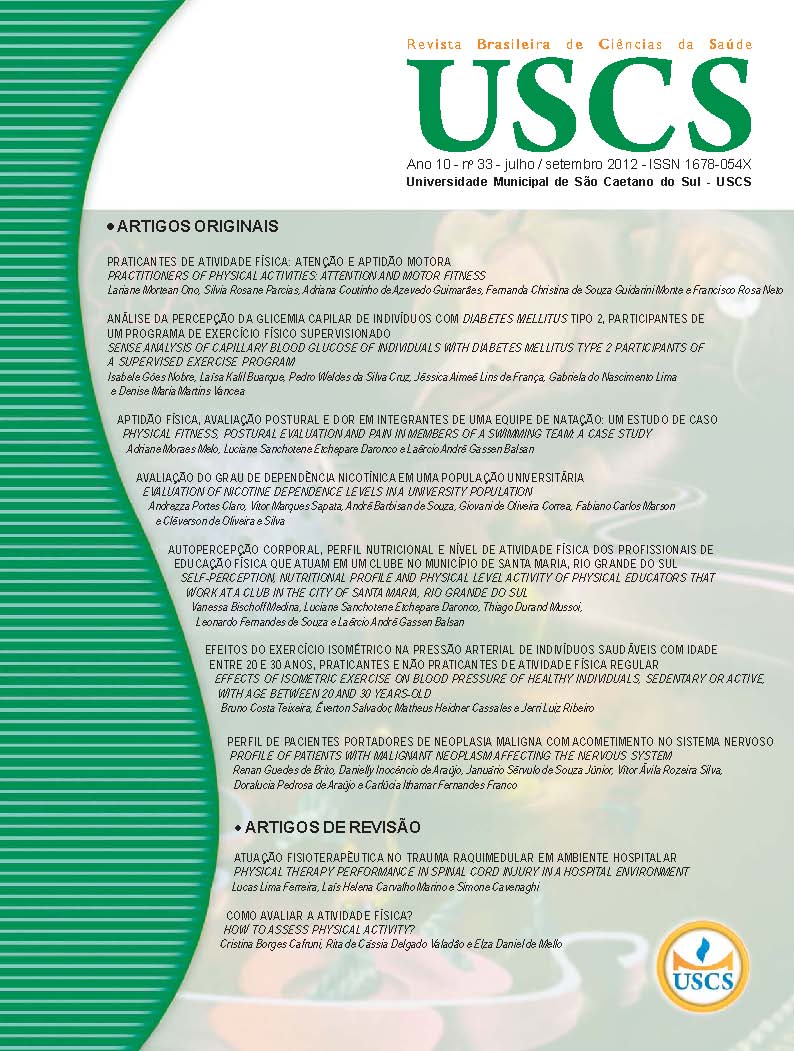Avaliação do Grau de Dependência Nicotínica em uma População Universitária
DOI:
https://doi.org/10.13037/rbcs.vol10n33.1516Keywords:
cigarro, transtorno por uso do tabacoAbstract
Introdução: A dependência nicotínica atinge uma grande parcela da população e estudos na literatura mostram que a maior parte dos fumantes iniciou o hábito ainda na adolescência, durante o período universitário. Desta forma, o trabalho avaliou o grau de dependência nicotínica de universitários fumantes, buscando relacionar o gênero como um possível fator predisponente. Objetivo: O trabalho avaliou o grau de dependência nicotínica de universitários fumantes, buscando relacionar o gênero como um possível fator predisponente. Materiais e métodos: Este estudo analisou o grau de dependência do tabaco em estudantes universitários da cidade de Maringá - PR. Realizou-se uma entrevista com 50 pessoas, entre elas 16 do sexo feminino e 34 do sexo masculino. A entrevista foi realizada através do teste de Fagerström. Resultados: Cerca de 62% dos indivíduos entrevistados possuem uma dependência leve, enquanto que em 20% a dependência é moderada e em 12% severa. Além disso, os homens tendem a apresentar um maior grau de dependência nicotínica, sendo que 18% dos homens e nenhuma mulher apresentou uma dependência grave. Conclusão: De acordo com os achados do presente estudo, pode-se concluir que os jovens universitários fumantes já apresentam algum grau dependência, sendo que em quase um terço dos indivíduos a dependência já é moderada ou severa.
Downloads
References
(1) Brasil. Ministério da Saúde. Tabaco é a droga
de 1,3 bilhões de pessoas no planeta. Brasília,
Portal da Saúde/SUS, 2001. [Acesso em
23 out 2010]. Disponível em:
saude.gov.br/portal/svs/visualizar_texto.
cfm?idtxt=21805>.
(2) Bain CA. Implant installation in the smoking
patient. Periodontol 2000. 2003; 33:185-93.
(3) Campbell HS, Sletten M, Petty T. Patient
perceptions of tobacco cessation services in
dental office. J Am Dent Assoc. 1999 Feb;
130(2):219-26.
(4) Grossi SG, Genco RJ, Machtei EE, Ho AW,
Koch G, Dunford R et al. Assessment of risk for
periodontal disease. II. Risk indicators for
alveolar bone loss. J Periodontol. 1995 Jan;
66(1):23-9.
(5) Willard N. Tabaco: o último suspiro. A saúde
do mundo. 1986 jan/fev;18-23.
(6) Andrade APA, Bernardo ACC, Viegas CCA,
Ferreira DBL, Gomes TC, Sales MR. Prevalência
e características do tabagismo em jovens da
Universidade de Brasília. J Bras Pneumol. 2006
Feb; 32(1):23-8.
(7) Rigotti NA, Lee JE, Wechsler H. US college
student’s use of tobacco products: results of
a national survey. JAMA. 2000 Aug; 284(6):
699-705.
(8) Wetter DW, Kenford SL, Welsch SK, Smith
SS, Fouladi RT, Fiore MC et al. Prevalence and
predictor of transitions in smoking behavior
among college students. Health Psychol. 2004
Mar; 23(2):168-77.
(9) Patterson F, Lerman C, Kaufmann VG, Neuner
GA, Audrain-McGovern J. Cigarette smoking
practices among American college students:
review and future directions. J Am Coll Health.
2004 Mar/Apr; 52(5):203-10.
(10) Everett SA, Husten CG, Kann L, Warren
CW, Sharp D, Crossett L. Smoking initiation and
smoking patterns among US college students. J
Am Coll Health. 1999 Sep; 48(2):55-60.
(11) DiFranza JR, Wellman RJ. A sensitizationhomeostasis
model of nicotine craving,
withdrawal, and tolerance: integrating the clinical
and basic science literature. Nicotine Tob Res.
2005 Feb; 7(1):9-26.
SAÚDE
32 Revista Brasileira de Ciências da Saúde, ano 10, nº 33, jul/set 2012
ARTIGOS ORIGINAIS
REFERÊNCIAS
(12) Colby SM, Tiffany ST, Shiffman S, Niaura
R. Are adolescent smokers dependent on
nicotine? A review of the evidence. Drug Alcohol
Depend. 2000 May; 59(Suppl 1):S83-95.
(13) Binnie VI. Addressing the topic of smoking
cessation in a dental setting. Periodontol 2000.
2008; 48:170-8.
(14) Centers for Disease Control and Prevention
(CDC). Tobacco use among adults –United
States, 2005. MMWR Morb Mortal Wkly Rep.
2006 Oct; 55(42):1.145-8.
(15) Breslau N, Johnson OE, Hiripi E, Kessler R.
Nicotine dependence in the United States:
prevalence, trends, and smoking persistence.
Arch Gen Psychiatry. 2001 Sep; 58(9):810-6.
(16) DiFranza JR, Rigotti NA, McNeill AD, Ockene
JK, Savageau JA, St Cyr D et al. Initial symptoms
of nicotine dependence in adolescents. Tob
Control. 2000 Sep; 9(3):313-9.
(17) Piasecki TM, Richardson AE, Smith SM. Selfmonitored
motives for smoking among college
students. Psychol Addict Behav. 2007 Sep;
21(3):328-37.
(18) Karp I, O’Loughlin J, Hanley J, Tyndale RF,
Paradis G. Risk factors for tobacco dependence
in adolescent smokers. Tob Control. 2006 Jun;
15(3):199-204.
(19) Kusma B, Quarcoo D, Vitzthum K, Welte T,
Mache S, Meyer-Falcke A, et al. Berlin’s medical
student’s smoking habits, knowledge about
smoking and attitudes toward smoking cessation
counseling. J Occup Med Toxicol. 2010 Apr; 5:9.
(20) Van der Veen JW, Cohen LM, Trotter DR,
Collins FL Jr. Impulsivity and the role of smokingrelated
outcome expectancies among dependent
college-aged cigarette smokers. Addict Behav.
2008 Aug; 33(8):1.006-11.
(21) Míguez Varela MC, Becoña Iglesias E.
Smoking among psychology students over a tenyear
period (1996-2006). Psicothema. 2009 Nov;
21(4):573-8.
(22) Al-Mohamed HI, Amin TT. Pattern and
prevalence of smoking among students at King
Faisal University, Al Hassa, Saudi Arabia. East
Mediterr Health J. 2010 Jan; 16(1):56-64.
(23) Al-Naggar RA, Al-Dubai SA, Al-Naggar TH,
Chen R, Al-Jashamy K. Prevalence and of smoking
and associated factors among Malaysian
University students. Asian Pac J Cancer Prev.
2011; 12(3):619-24.
(24) Huang B, Inagaki K, Yoshii C, Kano M, Abbott
PV, Noguchi T et al. Social nicotine dependence
in Australian dental undergraduate students. Int
Dent J. 2011 Jun; 61(3):152-6.
Downloads
Published
Issue
Section
License
Copyright (c) 2012 Andrezza Portes Claro, Vítor Marques Sapata, André Barbisan Souza, Giovani Oliveira Correa, Fabiano Carlos Marson, Cléverson de Oliveira e Silva

This work is licensed under a Creative Commons Attribution-NonCommercial-NoDerivatives 4.0 International License.
Policy Proposal for Journals offering Free Delayed Access
Authors who publish in this magazine agree to the following terms:
- Authors maintain the copyright and grant the journal the right to the first publication, with the work simultaneously licensed under a Creative Commons Attribution License after publication, allowing the sharing of the work with recognition of the authorship of the work and initial publication in this journal.
- Authors are authorized to assume additional contracts separately, for non-exclusive distribution of the version of the work published in this magazine (eg, publishing in institutional repository or as a book chapter), with the acknowledgment of the authorship and initial publication in this journal.
- Authors are allowed and encouraged to publish and distribute their work online (eg in institutional repositories or on their personal page) at any point before or during the editorial process, as this can generate productive changes, as well as increase impact and citation of the published work (See The Effect of Open Access).









